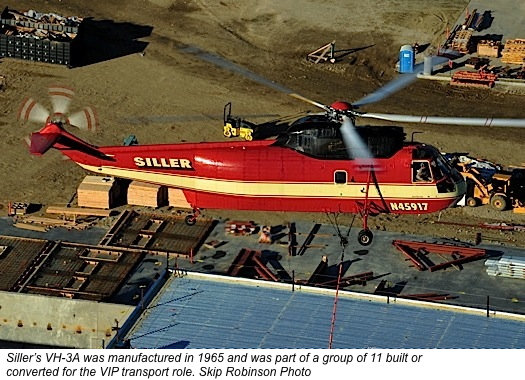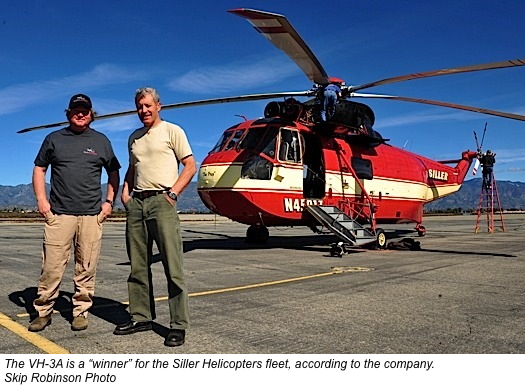
Siller Helicopters Inc. of Yuba City, Calif., operates a substantial fleet of early model Sikorsky helicopters, including some historically significant aircraft. These include the last S-64E Skycrane ever built, and a VH-3A — the VIP transport version of the venerable S-61/H-3 Sea King series.
Siller’s VH-3A was manufactured in 1965 and was part of a group of 11 built or converted for the VIP transport role (i.e., to carry the United States president and other dignitaries). While Siller’s helicopter was never part of the U.S. presidential fleet, it became part of the Indonesian air force for use by Indonesian president Sukarno. After Sukarno’s death, there were rumors the aircraft was haunted by his spirit, and the helicopter was eventually returned to the U.S.
After another company acquired the Indonesian VH-3A, it found its way into Siller’s hands. Since then, it has been flown primarily as a logging aircraft, but recently it has, among other things, been doing a variety of construction jobs — anything from placing drill rigs in remote mountainous areas, to setting transmission poles in sensitive wetlands, to setting rooftop air conditioners or other equipment at various building sites. Siller also uses the VH-3A as a U.S. Forest Service exclusive-use firefighting aircraft during the summer, where it’s operated with a fixed tank or a Bambi Bucket.
To accommodate this diversity of missions and the environments in which the helicopter operates, Siller’s VH-3A has had its engines upgraded from the General Electric CT58-110 to the more powerful CT58-140-1, providing an additional 150 horsepower per engine. Further performance upgrades include outfitting the aircraft with Carson composite main rotor blades, which provide roughly 1,500 pounds (680 kilograms) more lift, have much longer life, enable much better high-altitude performance and increase airspeed.

Doing the Job
In February of this year, Vertical was invited to go out on a construction job with Siller to see the VH-3A in action, get an idea of how the helicopter is used on a lift job, and learn how Siller plans for a lift job.
On this particular project — setting air conditioners and refrigeration equipment on a building — Jim Anderson, Siller’s director of sales and operations, told us initially about the planning and preparation the company went through: “Because the VH-3A is a restricted category aircraft, we submitted a contingency plan to the Riverside, Calif., FAA [Federal Aviation Administration] Flight Standards District Office for the approval of a non-congested area project. The aircraft [will] be operated out of Rialto [Municipal] Airport in San Bernardino, Calif., as [its] within a half mile of the Target distribution center building where the lift [will] occur.” In all, 22 lifts were planned, with no lift to exceed 7,400 pounds (3,357 kilograms), and the total job was forecasted to take 2.8 flight hours, including the transitions back to the airport for refueling. The heaviest lifts would take place at the end of the fuel cycles, ensuring the VH-3A could operate at its maximum performance on those lifts.

Anderson continued, “On this job, we [have] a landing zone at the job site; however, we choose to use the nearby airport for refueling to minimize the potential for blowing dust and debris. . . . During refueling we [will use] a single-point or closed-circuit refueling system. We use these on both our VH-3A and larger S-64 Skycrane — it allows for rapid refueling at much higher flow rates while the aircraft is at ground idle, and shortens our time back to the job. We [have] located our emergency landing zone in an open field to the east of the building we [are] working above. If the aircraft [experiences] a problem, we [will] side-step the building and set down.”
For further safety, Anderson said that before the job began Siller asked the contractor to have the roads to the north and west of the job site closed. This creates a safety barrier and keeps people and cars out of the area. “We like to do these jobs early on Sunday mornings, while everyone is still sleeping and few people and cars are in the area. Also, during the summer months the mornings are cooler, allowing the helicopter to perform [at] its best.”
Determining whether to close the roads comes from the reconnaissance Siller crews do before each lift job. Said Anderson: “The first thing we look for are obstacles and what might blow around and get in the way. We’ll also want to figure out the flight path and where the aircraft will go in an emergency. Other concerns include nearby roads/streets and the amount of traffic that may be affected during the job. In some cases, the helicopter’s flight path may not go directly to the lift job building’s roof. This may affect adjacent property or buildings and could require the occupants to be relocated during the job.

“We then need to examine what type of building is it: office, industrial, [or] factory, and how many floors do we need to remove occupants from? We also need to know the age and condition of the building and the condition of the roof. Is the roof new, repaired, partially finished, does it have items on it that aren’t well secured and can be blown off, damaging things below? The type of equipment and how it sets on the roof is [also] a critical item to review.”
All of these factors can be amplified or minimized depending on the length of the long line (the VH-3A normally uses 100 foot lengths). The rigging Siller uses is considered, as well: what type, lengths, how much, and what delays might ensue if crews do not have enough.
“We also look at the order of the lifts and what they weigh, the time required to set them, and how many lifts [are needed],” said Anderson. “This will dictate when we need to do a refueling cycle and how much fuel to put aboard.” Siller teams then consider the receiving ground crews and how quickly they can get the load placed and secured. On some projects, ground crews cannot keep up and the aircrews will need to slow things down — the VH-3A is capable of setting loads faster than ground crews can finish “bolting them up.”
On this particular job, everything went smoothly and all 22 lifts were accomplished successfully. Said Anderson: “We did three refuelings and the crews did a great job. We do this so often that we operate like a well-oiled machine. Sometimes, as would be expected, things can get complicated, but overall this was a smooth project.”
As far as how the VH-3A flies and its value to Siller, Anderson said: “The S-61 platform is a robust and powerful helicopter. It continues to provide a reliable and precision placement capability for the variety of loads we use it for. With lifts up to 10,000 pounds, it’s a winner. Together with our 20,000-pound lift S-64E Skycrane, the ‘Presidential’ VH-3A is a perfect complement to the Siller Helicopters fleet.”






